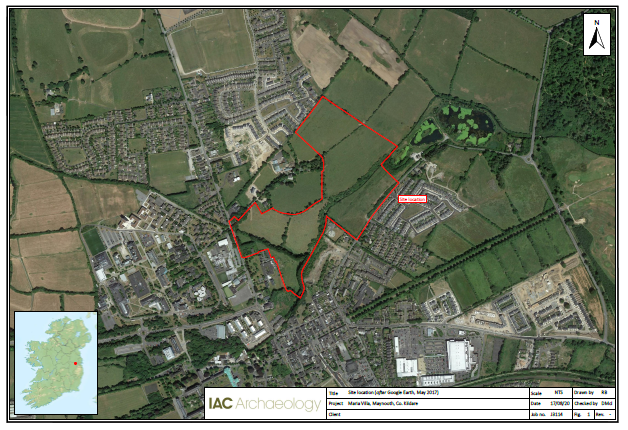2018:880 - MAYNOOTH: Maria Villia, Kildare
County: Kildare
Site name: MAYNOOTH: Maria Villia
Sites and Monuments Record No.: N/A
Licence number: 17E0208
Author: Tim Coughlan, F. Murtagh, D McIlreavy, M. Ni Cheallachain, D. Bayley & D. Spencer, c/o IAC Ltd.
Author/Organisation Address: Unit G1 Network Enterprise Park, Kilcoole, Co. Wicklow
Site type: Enclosure, Ring-ditch and Metalworking site
Period/Dating: Multi-period
ITM: E 693717m, N 738242m
Latitude, Longitude (decimal degrees): 53.386022, -6.591209
Archaeological excavations were undertaken at Maria Villa, Maynooth, Co Meath. Two distinct chronological phases (Phase 1 and 2) of archaeological activity were revealed, spread across the development site, which was sub-divided spatially into Areas 1 to 3. The first phase consisted of a prehistoric ritual complex comprising a large penannular enclosure and annular ring-ditch, with a cluster of associated features including an internal post and stake structure, an exterior post-hole row, pits, and post-holes. These features represent the earliest phase of activity during the Late Bronze Age/Early Iron Age (6th to 4th centuries BC). Peripheral metalworking activity dates to the Late Iron Age period (1st century BC to 2nd century AD) and consists of a number of hearths and iron-smelting furnaces (with associated pits and spreads) identified across the three archaeological areas.
Phase 1 dates to the Late Bronze Age/Early Iron Age. The earliest activity (Area 2A) represented a ritual complex, dated to 756–415 cal BC, and comprising a large penannular enclosure, with associated likely contemporaneous internal pit-like features. Finds included the remains of four undecorated bucket/barrel-shaped vessels from the top fill of the enclosure ditch. A potential internal ‘porch’ feature, located to the west of the enclosure entrance, was radiocarbon dated 748–403 cal BC. The post-holes contained fragments of burnt animal bone which may reflect feasting activities. No habitation evidence was found within the enclosure which suggests a ritual function for the remains represented at Maria Villa.
To the east of the enclosure was a circular ring-ditch radiocarbon dated to 537–392 cal BC. No cremated human bone was recovered; however, burnt animal bone was recovered from the pit fills, while charcoal, hazelnut shell and barley was identified within the ditch.
Phase 2 dated to the Late Iron Age and consisted of a series of hearths, furnaces and associated features represented metalworking activity scattered across the development area (Areas 1B, 2A, 2B, 3A and 3B). A hearth in Area 2A and an iron-smelting furnace in Area 2B both were radiocarbon dated to 48 cal BC–cal AD 67, and a second iron -smelting furnace in Area 3A was slightly later, dating to cal AD 5–127. A single pit of unknown function, in Area 1A, also dated to 94 cal BC–cal AD 56 and may be associated with metalworking activity. The features show a change in landscape use from one of ritual to that of domestic/industrial.
A later post-medieval linear ditch was also recorded (Area 1C) and may relate to drainage.

